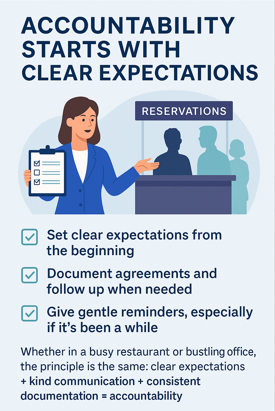
On New Year’s Eve, my wife and I went out for dinner for the first time in years. Normally, I avoid crowds that night, but this year I had a craving for my favorite Japanese hibachi grill. I called early in the day and reserved a table for 7 o’clock. We arrived about 15 minutes early. As we waited, I watched the growing crowd of guests hoping for a table. Customers were getting visibly frustrated, and the three hosts at the front were doing their best to stay professional and polite. You could tell they were trying to maintain good customer service under pressure.
At one point, a guest approached the host stand and complained that their group had been waiting for over an hour, even though they’d been told the wait would be an hour and twenty minutes. The hostess calmly checked the list and found the party’s name: a group of eleven added at 6:38 pm. It was now 6:55. With documentation in hand, the hostess gently showed the guest that only 17 minutes had passed, and they were still scheduled for their 8 o’clock seating.
The hostess did not get defensive or argue. She simply presented the facts with professionalism and kindness. It was a masterclass in calm, respectful accountability.
This wasn’t just a fluke of good customer service; it was a real-world example of how positive accountability can play out in action. Experts agree that accountability in the workplace starts with clarity, communication, and proactive leadership (Forbes, 2023).
The Power of Documentation in the Workplace
This simple restaurant experience held a big lesson: accountability in the workplace begins with clarity and documentation. Just like the hostess used her reservation sheet to keep the situation on track, leaders and team members should use tools like:
- Meeting notes
- Project management software
- Email follow-ups
- Clearly defined expectations
Leadership experts, like those at Harvard Business Review, emphasize that clear documentation is one of the most effective ways to prevent misunderstandings and support performance improvement.
When you document agreements, deadlines, and responsibilities, you protect everyone involved. It allows for transparent communication, avoids unnecessary conflict, and gives you something to reference when expectations aren’t met.
Employee Accountability and Workplace Culture
When done respectfully and professionally, holding someone accountable isn’t rude, it’s responsible. In fact, it’s essential to building trust, productivity, and healthy relationships at work.
But how do you do it?
Here are a few helpful tips:
- ✅ Set clear expectations from the beginning
- ✅ Document agreements and follow up when needed
- ✅ Give gentle reminders, especially if it’s been a while
- ✅ Communicate early if you or someone else won’t meet a commitment
- ✅ Check yourself first: Are you meeting your commitments?
As much as we’d love for everyone to follow through 100% of the time, humans are the wild card. Sometimes people make commitments they forget, or circumstances change, and they can’t follow through. That’s where documentation and open, professional communication become your strongest tools.
BetterUp also notes that accountability is most effective when paired with ongoing communication and support, not just correction.

Personal Responsibility and Accountability at Work
Before pointing fingers or placing blame, take a look at your role. Are you organized and proactive? Have you fulfilled your side of the agreement? Are you clear in your communication?
When accountability is built into your workplace culture, it becomes easier and more natural to hold others to the same standard. It creates a sense of mutual respect where expectations are known and responsibilities are met.
Final Thoughts
Whether in a busy restaurant or a bustling office, the principle is the same: clear expectations + kind communication + consistent documentation = accountability. It’s not about catching people in a mistake; it’s about helping everyone stay on track, keep their word, and move forward together.
For more insights on building healthy accountability, check these excellent resources from Forbes, BetterUp, and Harvard Business Review.
References
BetterUp. (2023, September 11). What does accountability look like in the workplace? https://www.betterup.com/blog/accountability-example
Knight, R. (2020, November 10). How to actually encourage employee accountability. Harvard Business Review. https://hbr.org/2020/11/how-to-actually-encourage-employee-accountability
Reardon, D. (2023, October 18). 5 steps to inspire positive accountability in the workplace. Forbes. https://www.forbes.com/councils/forbeshumanresourcescouncil/2023/10/18/5-steps-to-inspire-positive-accountability-in-the-workplace/
Image Credits
CloudAnybody1. (n.d.). How to be a good host at a restaurant [Infographic]. Bitbucket. https://cloudanybody1.bitbucket.io/how-to-be-a-good-host-at-a-restaurant.html
OpenAI. (2025). Accountability starts with clear expectations [Infographic]. ChatGPT. https://chat.openai.com/

